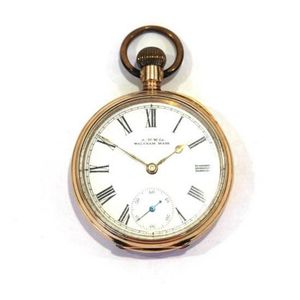Dent 18ct Gold Half-Hunter Pocket Watch, Keyless Wind
You must be a subscriber, and be logged in to view price and dealer details.
Subscribe Now to view actual auction price for this item
When you subscribe, you have the option of setting the currency in which to display prices to $Au, $US, $NZ or Stg.
- Fusee - The fusee movement was used in clocks and pocket watches from the mid 17th century. The fusee is a cone shaped drum within the works that is linked to the barrel of the spring, usually by a length of chain.
As the mainspring loses its tension over time, the cone shaped barrel compensates for this by increasing the tension, by pulling the mainspring tighter, thus ensuring the time remains constant.
Use of the fusee in clocks was superseded by the "going barrel" in the mid 19th century and for pocket watches at the beginning of the 19th century.
The fusee continued to be used in marine chronometers until the 1970s. - Keyless Watch - A keyless watch is a type of pocket watch or wristwatch that does not require a separate winding key to wind or set the time. Instead, a keyless watch is wound and set by a small knob or button located on the side of the watch, called a crown.
Keyless watches were first introduced in the late 19th century and quickly became popular due to their convenience and ease of use. Prior to the development of keyless watches, pocket watches were typically wound and set using a small key that was inserted into a hole in the watch case. The key would be turned to wind the watch's mainspring, and then turned again to set the time.
With the introduction of the keyless watch, watchmakers were able to simplify the winding and setting process by eliminating the need for a separate key. Instead, the crown on the side of the watch could be pulled out to set the time, and then pushed back in to wind the watch's mainspring.
The keyless watch design has since become the standard for most modern watches, both pocket and wristwatches. In addition to being more convenient to use, keyless watches are also typically more reliable and accurate than earlier models that used winding keys. - Half Hunter - A half-hunter (or "demi hunter") pocket watch is one in which the outer lid over the face of the watch has a cut out centre section, enabling the owner to view the hands to tell the time, without having to open the lid. On some half-hunter watches, the hours are marked on the outer lid.
- Movement - The technical name for the workings of a clock or watch, and does not include the dial or case.
This item has been included into following indexes:
- Dent, Edward (Britain) - clocks, maker or retailer 49
- pocket watches, case type
Visually similar items

Breguet Ancre 18ct gold half hunter pocket watch, engraved inside the dust cover 'Ancre, signe Droite, 15 Rubis spiral Brequet no 26823' and marked 18ct total weight 87 grams. Enamel dial perfect and hands have tiny diamonds inserted. Very tiny minor dent

A 10ct yellow gold gentleman's A.W.W Co Waltham pocket watch, white dial, black Roman numerals, gold hands and second subsidiary dial with a 10ct yellow gold case, manual movement in good working condition, Wt 80.4 grams

An open face pocket watch, white dial, Roman numerals, subsidiary seconds dial on a plate movement in a rolled gold case. Not working.

An 18ct. gold cased pocket watch, open face with a white enamel dial, Roman numerals, railtrack minutes and subsidiary seconds, the lever wind movement signed J.B. Yabsley, 72 Ludgate Hill, London, gold dust cover, hallmarked back cover. Case weight (incl.
